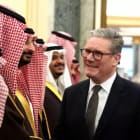Saudi's $8.3 Billion Bet on the Green Economy
The all-Saudi team reflects a focus on Saudi interests.
On 14 July, Saudi Arabia’s ACWA Power, Badeel, and Saudi Aramco Power Company (SAPCO) signed “the largest and most comprehensive agreement to date under the National Renewable Energy Programme (NREP)”—an approximately $8.3 billion deal to develop seven solar and wind projects. While this aligns with Riyadh’s Vision 2030 goals for economic diversification and a 50% renewable energy mix by 2030, earlier green energy pledges have yielded limited results. The new deal also comes as international partners increasingly prioritise oil and gas amid heightened geopolitical volatility following the Iran-Israel war.
A Bet on Saudi
The ACWA-led consortium signed power purchase agreements (PPAs) with the Saudi Power Procurement Company (SPPC) for five new solar photovoltaic plants and two wind power plants, with a combined capacity of 15,000 MW. This forms part of Saudi Arabia’s broader push to reduce emissions and meet its net-zero targets.
The all-Saudi team reflects a focus on localisation, interpreted as a strategic effort by Riyadh to bolster its domestic economy and mitigate dependence on foreign direct investment (FDI) amid heightened tensions. Although Vision 2030’s local content requirements already mandate sourcing a significant portion of project components domestically, the Iran-Israel war and Iran’s missile strike on Qatar’s Al Udeid Air Base have highlighted vulnerabilities in global supply chains, particularly those linked to US military and economic alliances. These events have not only driven oil prices above $100 per barrel temporarily but also exposed deficiencies in US-led supply networks, prompting Riyadh to accelerate inward-looking policies.
Saudi Arabia’s strategy to scale up renewable energy is not just about meeting domestic electricity demand. A central pillar of the policy is the indirect export of hydrocarbons. At present, the Kingdom still relies heavily on crude oil and natural gas for electricity generation, especially during high-demand summer months. By substituting this domestic power generation with solar and wind, every megawatt-hour of clean energy effectively liberates a barrel of oil or a cubic metre of gas for export. This not only reinforces Saudi Arabia’s fiscal and external balances but also aligns with Aramco’s broader strategy of maximising the value of each exported unit of hydrocarbon, particularly under volatile global market conditions.
Keep reading with a 7-day free trial
Subscribe to MENA Unleashed to keep reading this post and get 7 days of free access to the full post archives.




